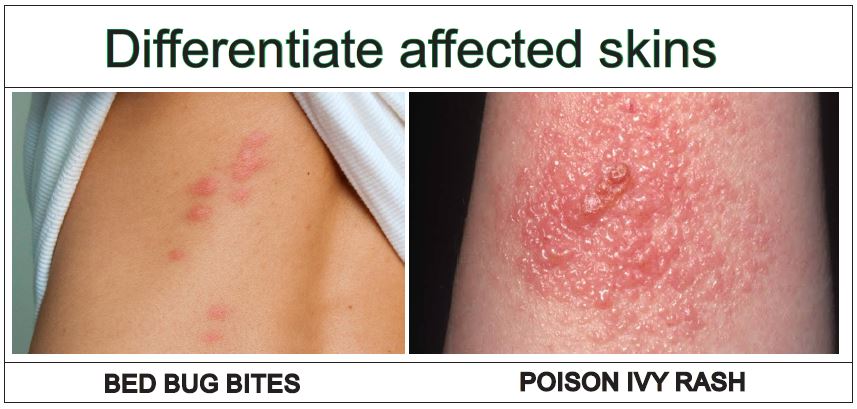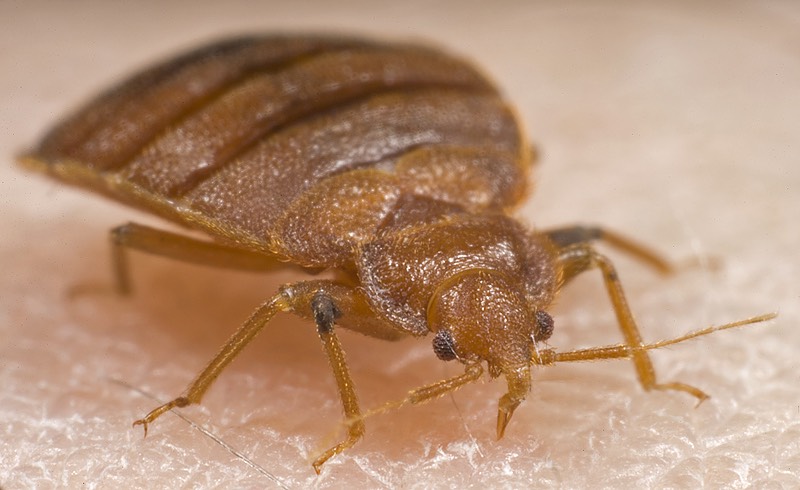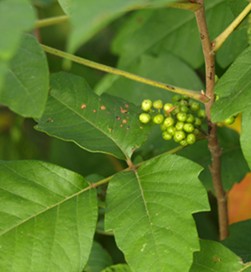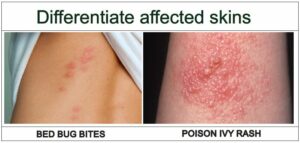BED BUG BITE POISON IVY RASH
Poison ivy is one of the most common poisonous plants in North America.
It grows in wooded areas and has shiny, pointed leaves. The sap from the plant contains urushiol oil, which is responsible for the rash.
The rash starts with small red bumps that become itchy and painful. The rash may take up to two weeks to disappear.
1- What Is Poison Ivy?
Poison ivy has been around for a long time. White oak, poison oak, English ivy, and woodbine are some of the names. The plant is also known as poison ivy.
If you touch a poisonous plant or an object that’s been in contact with it, you’ll get a rash. The rash is caused by allergies.
You can get an itchy rash by touching a poison ivy plant, but you can also get it from touching clothing or a pet that has been exposed to it.
1- What Is Bed bugs?
Bed bugs are tiny, dark-colored insects with six legs. They live in cracks and crevices in furniture, upholstered items and even in mattresses.
They can hide in places that make it difficult to find them, so it’s important to be aware of your surroundings when you’re sleeping.
Bed bugs are common in many countries and some places have become more prevalent than others.
This is because of poor sanitation practices and infestations often occur in low income neighborhoods.
Poison Ivy vs Bug Bite

Image Credits: Joe – bug bites vs poison ivy pictures
2- Poison ivy Symptoms
If you have a rash that is not caused by an insect bite, you may have been exposed to poison ivy. Poison ivy is a member of the plant family Urticaceae (a plant that produces a milky sap), and is found throughout North America.
The oil from poison ivy contains urushiol. Urushiol is a natural chemical that irritates your skin and can cause an allergic reaction.
Urushiol is the oil that gives the poison ivy plant its characteristic itch. It is a sap that oozes from the plant’s leaves.
2- Bed bugs Symptoms
Eggs are round, white, and about 1/4″ in diameter. They are usually laid on top of the host and can be seen through clothing.
They are often found in clusters, and are very difficult to remove without damaging the host.
3- Types of Bed Bugs & Bites
There are two types of bedbugs:
- The American bedbug (Cimex lectularius)

Image Credits: identify.us.com
- The Oriental bedbug (Cimex hemipterus)

Image Credits: faculty.ucr.edu
Both species feed on blood and are very similar in appearance. However, the American bedbug is generally larger than the Oriental bedbug.
Bedbugs feed mainly at night and are most active when temperatures are cooler and the air is still. Bed bugs are known for their distinctive bite, which has a characteristic reddish color.
They are also infamous for their ability to hide in the most unlikely places.
The bite itself is usually located on the back of the hand, arm or shoulder, or on the legs. Bed bug bites are often mistaken for mosquito bites, especially when the bite is itchy.
The pain of a bed bug bite can be intense, even though they are not venomous.
3- Types of Poison ivy plants
Poison ivy plant. There are three leaflets in a poison ivy plant. It can be a low plant or vine.
Low-lying poison ivy plants are usually found among groups of weeds and other plants.
(i) Poison Ivy Plant with Berries

Image Credits: Lawn-care-academy.com
Poison ivy is a perennial vine that grows up to 5 feet tall. It has sharp thorns on the stem and branches.
The leaves are dark green with jagged edges and are covered with small bumps called urticating hairs. The berries are tiny and are poisonous when eaten.
(ii) Poison Sumac Plant

Image Credits: In defence of plants
The poison sumac plant is a member of the Rose family and grows as a bush or tree.
Unlike poison ivy and poison oak, it doesn’t grow in a three-leaf per stem pattern.
The cause of poison ivy rash is an allergic reaction to urushiol. It’s found in poison ivy and poison oak.
I have had a bad experience with resin, and I am always careful when using it. It’s important to wear gloves when working with resin because it can cause an allergic reaction.
4- Bed Bug Complications
People with severe reactions can experience a wide range of symptoms, such as:
- • Itching
- • Rash
- • Swelling
- • Bleeding
- • Redness
- • Pain
- • Numbness
- • Difficulty breathing
- • Fatigue
People who experience these symptoms should contact their doctor immediately.
4- Poison Ivy Complications
Poison ivy is a common problem in the United States. The plant’s oil is found in the leaves and stems.
The oil is released when you touch the leaves or stems. The oil can irritate the skin and cause a painful rash.
5- Bed Bugs Prevention
Bed bugs are very attracted to warm bodies, so if you spend a lot of time in bed, or you’ve been sleeping on the couch, then you may want to check your bed for bed bugs.
If you find any signs, it’s best to call a professional pest control company to remove them as quickly as possible.
They can be found on furniture, carpets, clothing, beds, and even walls. They can live for months without food, so they don’t need to feed very often.
They are a common pest in many countries, especially in tropical climates. It is recommended that you check your hotel for bed bugs before you book.
5- Poison Ivy Rash Prevention
To prevent poison ivy rash, follow these tips:
Poison ivy, poison oak and poison sumac are not to be taken lightly.
- Some species of poison ivy are known to cause skin damage, but there are many species of this plant and people often confuse them.
Be sure to wear proper clothing, socks, pants, and long sleeves when outdoors.
- If you live in an area with many trees, you should make sure your pet doesn’t run through those trees or brush.
Wash your skin with soap and water as soon as you notice the rash to help prevent further injury and the spread of poison ivy to your pets.
- Wash your hands often, especially if they are in contact with your skin. A mild soap can be used, but it should be scrubbed under the nail.
Before you give your pet a bath, make sure to put on rubber gloves. Cleaning contaminated items begins with washing your clothes.
- Make sure to wash your clothes in warm soapy water.
If you want to avoid transferring urushiol to your skin, furniture, rugs or other household objects, you’ll have to handle your clothing carefully.
- detergents specifically formulated for fabric will wash your clothes and linens. Hang-dry your garments and use a hot water wash to make sure they are clean.
For a while, Urushiol can remain potent. If you want to remove the oil from your skin, you have to wash the jacket thoroughly.
6- Bed Bug Bites Treatment
Wounds caused by bed bugs usually appear as red bumps surrounded by a yellowish crust. They are generally painless but can become painful if they become infected.
The itchiness is often worse at night. The bites can be itchy for several days.
If you see an insect bite that is not from a bed bug, contact your doctor to be sure you do not have a disease that requires immediate medical attention.
A dramatic immune response may be a sign of an allergic reaction. An allergic reaction is when your immune system overreacts to a foreign substance, such as pollen, dust, or food.
This overreaction can cause inflammation and swell in the affected area. If an allergic reaction is suspected, you should seek medical attention immediately.
6- Poison Plant Rashes Treatment
There is no way to spread poison plant rash from one person to another.
It’s easy to get a rash from using products containing aloe vera, especially when the plant oil gets rubbed into the skin.
- Essential oils have an interesting quality they last longer than any other part of the plant and are often not washed away even with water and rubbing alcohol.
The rash is caused by the plant oil touching the skin. A person with poison ivy can’t spread it to others.
A skin care regimen that contains an antibacterial product, such as Dermex, will help the skin to heal faster and can even help the skin to recover if it is bitten by a bug.
It is possible that the nails are affected by something other than the plant oil that is absorbed into the nail. A good rule of thumb is to only use it in a spot that you are comfortable using.
FAQs
1- What About Bed Bug Eggs?
The best way to control bed bugs is to identify and destroy their eggs.
The bed bug’s egg case can be seen as a small, brown, oval-shaped object that is attached to the underside of a bed sheet or pillowcase.
To control the bed bugs, you must remove the bed bug’s eggs from the infested area.
2- Can a Bug Bite Look Like Poison Ivy?
Yes! They both look the same from the outside!
Poison ivy is a plant that grows in patches of small blisters. It is not always easy to know if you will get a bite. The affected skin can look red if they get a sunburn.
The skin may become dry and white in time. Bed bugs like dead or living things. They stay away from blankets to stay warm.
3- Does the Bug Bite Thing Work on Poison Ivy?


Moreover! If you touch any part of the poison ivy plant, you may experience a painful rash, blisters and severe itching, which can be as quickly as hours after exposure
A poison ivy rash usually resolves on its own in two to three weeks.


For irritated skin, use a topical anti-inflammatory like calamine lotion.
4- Can You Get Poison Ivy from A Bug Bite?
The answer depends! It is highly likely that you will get a poison ivy rash and a big bite if bed bugs live around poison ivy plants.
5- How to Tell the Difference Between a Bug Bite and Poison Ivy?

This image shows a huge difference between the two. Bites from beg bugs appear as a single round spot, while poison appears as a bunch of small round spots.
6- How to Tell Bug Bites from Poison Ivy?
A poison ivy rash can be very painful, but a bed bug bite is much less painful. Poison ivy doesn’t cause bumps, that’s why it’s itchy.
7- Is There a Bug Bite that Looks Like Poison Ivy?
No! Poison ivy rash doesn’t look like bed bug bites however initial bite symbols looks like red and itchy.
